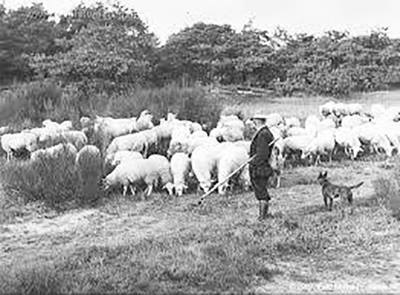
Written by Pauline van Vliet
This “extraordinary ordinary dog” as its aficionados call it, has long been virtually unknown outside its native country.
The breed’s roots lie in The Netherlands; there are 18th century pictures showing dogs of this type, but since much longer before the Dutch farmers and shepherds had been employing dogs. Versatile farm dogs, their main task was escorting sheep (often a large combined flock made up of several smaller flocks, tended by the village shepherd) on their way from the village to the grazing area and back home at the end of the day.
By the time the sheepherding era was coming to an end, the purebred dog fancy had discovered the breed, which likely has saved it from disappearing along with the flocks. From 1875 on, Dutch shepherd dogs began to appear at dog shows; the first dogs entered in the Stud Book were born in 1895, and in 1898 a breed club was established. Both as companion dog and as police dog the breed was in demand.
When browsing through antique dog books and photographs, one may be amazed to find how much some breeds have changed over the years – and how little have others! The Dutch shepherd dog belongs to the second category. The breed standard paints a picture of a medium sized, soundly built dog without any exaggerated points. They come in three coat types: short hair, long hair and rough (wire) hair. The coat colour is brindle, although some fawn dogs exist (not a recognized colour anymore).
It is a suitable breed for people able to appreciate a smart(ass) dog, always ready to go where action and fun may be found, enjoying cooperation with its human but not entirely without plans of its own (“Just let me I’ll fix it!”). Dutch shepherds can be found in any branch of dog sport, be it agility, obedience, dog dance, tracking, protection work or whatever. They do well as pets provided they get sufficient outlet for their energy. Note: the level of hardness and the amount of work drive may vary from line to line within the breed. When looking for a puppy, do your homework in order to find the right breeder.
The last 25 years saw a rapid growth of interest in the breed outside Holland. All over Europe, and even beyond, clubs have been established to promote the breed’s interests. In several countries with an open registry some shorthaireds from police dog lines have been registered, mostly from Malinois-tinged ancestry. The idea behind this is to enhance work drive, as well as expand the genetic pool.
The longhaired and roughhaired varieties are both rather small populations in need of fresh genes; to solve this, some matings with shorthaireds will take place.

This is my 2nd long hair, Anna’s Connery van Inlands Akker (Cai) photo have been a son of his 8 -month old named Woody Woodstock v Kevin’s Cot.
The Dutch Shepherd is very loyal and reliable, always alert , vigilant and active. He is independent , social, intelligent, perseverance and willingness to obey. Thanks to these characteristics it is not only a popular working dog but also a great family dog. The Dutch Shepherd is versatile and for all
He’s quite stunning!!